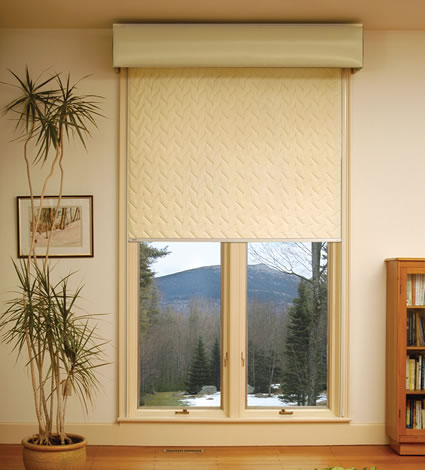Cellular Shade
This article has details on both insulated cellular shades and window quilts.
Fabric selection can have a big impact on both visual and thermal performance for both cell shades and window quilts. Ask your retailer or product supplier for product-specific thermal and visual performance information based on fabric weave, color, weight, and type of material.
Automation (motors, sensors, remote controls) can have a big impact on both performance and cost; for details, see our fact sheet on window covering automation.
Description
Insulated cellular shades and quilted window blinds provide all the benefits of conventional shades and blinds, but offer markedly better thermal performance, particularly in cold climates. Both provide insulation by effectively trapping air within their cores as well as between the shade or blind and the window. Both are available with a metallized polyester layer (radiant barrier) to further boost thermal insulation. Insulated shades and blinds with a reflective outer surface reduce unwanted solar heat gain. To save energy, shades and blinds must be deployed.
Insulated Cellular Shades
Insulated cellular shades are made of a pleated material and designed to fold up, accordion-like, usually at the top of the window but sometimes at either top or bottom, which provides maximum adjustability for daylight control, view, and privacy. Some insulated shades contain multiple air layers in a honeycomb cross-section. Insulated cellular shades are typically installed inside the window opening. The best-performing cellular products fit into edge tracks with good weather stripping to control air leakage (see photo). Motorized operation and automated controls are available with some products.

The side tracks available for many insulated cellular shades significantly improve their thermal performance. The magnetic strips that secure the side tracks make for easy adjustment and removal of the entire window treatment, as needed.
Quilted Window Blinds
Quilted blinds are typically face mounted and either roll up at the top of the window—with the roll exposed or hidden by a valance—or pull up so that the fabric is folded at the top of the window. Some vertical folding options are also available. The vertical edges of quilted roller blinds fit into edge channels, the bottom edge has foam or felt gasketing, and the top of the blind fits snugly against a compression bar. Motorized operation is available with some products. Less expensive (and less adjustable) quilted window blinds are available that use continuous Velcro or snaps to attach the blind to the window trim.

Window quilts such as this one fit tightly against the window trim, running in side tracks and fitting snugly against both the top roller mechanism and the window stool.
Photo: Window Quilt Insulated Shades
Overall Thermal Performance
Insulated cellular shades without side tracks increase the insulating (R-) value of windows by about 1–2. Insulated cellular shades with side tracks and quilted window blinds with similar tight-fitting perimeters increase the R-value by about 4.
Key Benefits
- Provides privacy
- Reduces nighttime heat loss through windows
- Minimizes cold drafts near windows
- Reduces unwanted daytime solar heat gain through windows during the summer
- Controls daylight—most effective with blinds that both lower from top and raise from bottom
Key Drawbacks
- Full benefit requires proper deployment at all times
- Fully deploying blinds eliminates views through windows
Aesthetics
- Quilted blinds objectionable to some because of utilitarian appearance
- Greater variety in color and style available with cellular
- blinds than quilted blinds
Tips/Cautions
- Consider product warranty; specific term warranties
- (e.g. 5-year) or transferable lifetime warranties are better.
- Consider professional installation, particularly of roller quilted window blinds.
- Maximum savings depends significantly on routine adjustment.
- There is some potential insulated glazing unit damage when high performance insulated shades or blinds are used with double-pane sealed windows for controlling solar heat gain.

Top-down/bottom-up insulated cellular shades provide among the strongest combination of thermal performance, privacy, daylighting, glare control, and view.
Photo: Hunter Douglas
When To Consider
- Existing windows are old, leaky, and in relatively poor shape.
- Climate is cold, so reducing heat loss in the winter months is a top priority.
When to consider this retrofit—Ownership
| x | Homeowner |
| x | Apartment Renter - Long Term |
| Apartment Renter - Short Term | |
| x | Live in a Condo |
| x | Live in a Historical District |
When to consider this retrofit—Window conditions
| x | Existing window single-glazed |
| x | Existing window double-glazed, no low-e* |
| Existing window double-glazed with low-e |
* low-emissivity coating
Recommended Installer
| x | Do it Yourself (most insulated cellular shades) |
| x | Carpenter |
| x | Manufacturer or supplier |
Complementary Options
- Window repair
- Exterior awnings or shades
Operation
| x | Motorized |
| x | Sensor |
| x | Manual |
Considerations
| 1 | 2 | 3 | 4 | 5 | |
| Ease of Installation (low = easier) |
x | x | |||
| Availability (low = more available) |
x | x | x | ||
| Cost (low = lower cost) |
x | x | x |
Average Total Cost for 30- by 60-inch window
| Roller quilted window blind | $225 |
| Top-down/bottom-up insulated cellular shade with side tracks | $525 |
Digging Deeper
Energy Modeling Tools for Professionals
| RESFEN | |
| EnergyPlus-based tools | |
| x | WINDOW 6 |
